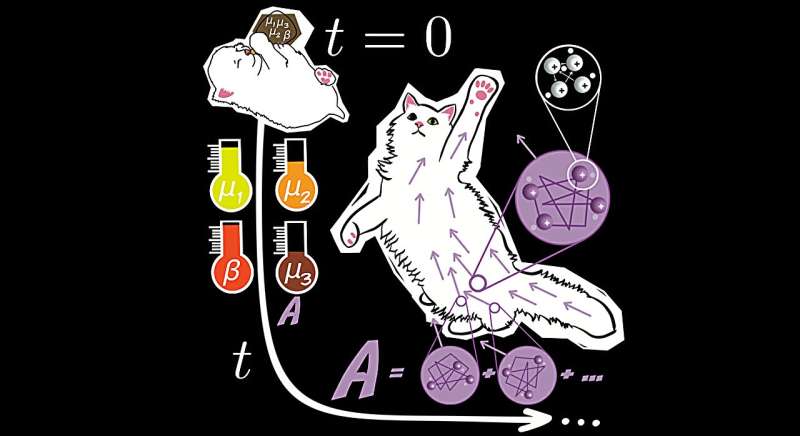A breakthrough in theoretical physics is an important step toward predicting the behavior of the fundamental matter of which our world is built. It can be used to calculate systems of enormous quantities of quantum particles, a feat thought impossible before.
The new University of Copenhagen research may prove of great importance for the design of quantum computers and could even be a map to superconductors that function at room temperature. The paper is published in the journal Physical Review X.
On the fringes of theoretical physics, Berislav Buca investigates the nearly impossible by way of “exotic” mathematics. His latest theory is no exception. By making it possible to calculate the dynamics, i.e., movements and interactions, of systems with enormous quantities of quantum particles, it has delivered something that had been written off in physics. An impossibility made possible.
The unexpected presence of a white cat adorns the illustrations of Buca’s research. Pulci the cat is his eye-catching muse. Arrows through the cat’s body illustrate the quantum mechanical origin of the playful cat’s movements—and this is precisely the relationship that Buca is trying to understand by making it possible to calculate the dynamics of the very smallest particles.
The breakthrough has reinvigorated an old and fundamental scientific question: Theoretically, if all behavior in the universe can be calculated by way of the laws of physics, can we then predict everything by calculating its smallest particles?
“Many physics disciplines are ultimately about explaining and predicting the world by understanding the laws of physics and calculating the behavior of the smallest particles. In principle, we would be able to answer any possible question about how all sorts of things behave if we were able to,” says Buca of the University of Copenhagen’s Niels Bohr Institute.
“In principle, the behavior of everything in the universe can be understood from the microscopic laws that govern particle dynamics,” he says, while quickly appealing for caution.
“Of course I can’t do that,” says the theorist.
A theoretical shortcut avoids the devil in the details
The interactions and movements of quantum particles in their systems are so complex, the researcher explains, that even the world’s most powerful supercomputer today is only able to perform calculations on a dozen of these particles at a time.
At the same time, a single atom consists of at least two quantum particles, and a single grain of sand of about 50 billion times a billion atoms—not to mention a cat or anything else one would want to understand in our universe.

“So in practice, it isn’t possible. Not currently. However, my theory is a significant step in the right direction. This is because it takes a kind of mathematical shortcut to understanding the dynamics of the whole, without computing power being lost in the details for a broad class of systems with many quantum particles. That is, without the need to calculate all of the individual particles in a system,” explains Buca.
The theory has already made a name for itself by providing the first mathematical proof of a long-held hypothesis in theoretical physics.
Up until now, the so-called eigenstate-thermalization hypothesis has been an assumption—an educated guess—in physics that had yet to be explained mathematically. It concerns the ability of mathematics to describe the motions of quantum systems as wholes.
Thus, Buca’s theory has already demonstrated its value as basic theoretical research, and accomplished what theorists had long considered impossible. While the results mainly interest the bright minds of physics for now, the consequences could eventually be great for us all.
A compass for the quantum-mechanical treasure map
This knowledge could end up showing the way to sought for quantum materials with properties so unique that they could transform our world.
These quantum materials are a prerequisite for digging our claws into some of the greatest scientific “birds on the bush”—such as stable quantum computers or even superconductors that work at room temperature.
“We are looking for a material for quantum computers that can withstand entropy—a law of nature that causes complex systems—e.g., materials—to decay into less complex forms. Entropy destroys the coherence needed for quantum computers to be stable and keep working,” Buca explains.
The exotic math systems that initially inspired him and made his research breakthrough possible may be just what a quantum computer needs to be truly useful.
“The so-called qubits that a quantum computer theoretically works with must be in a state of superposition to function, meaning that they are simultaneously turned on and off—in common phrasing. This requires them to be in a stable quantum state. However, thermodynamics does not like the structures required by the current materials. My theory may be able to inform us whether these exotic systems can be a way of structuring things so this quantum state could be more permanent,” says Buca.
The method is a bit like a road map that can guide researchers across a vast landscape of possible materials by allowing for predictions of how these materials would behave under experimental conditions. For the first time, this gives researchers a way to target their search for quantum materials equipped with special properties.
“Until now, the hunt for these materials has been governed by chance. But my results can, for the first time, provide a guiding principle to navigate by when searching for unique properties in materials,” says Buca.
More information:
Berislav Buča, Unified Theory of Local Quantum Many-Body Dynamics: Eigenoperator Thermalization Theorems, Physical Review X (2023). DOI: 10.1103/PhysRevX.13.031013
Citation:
‘It’s ultimately about predicting everything’—theory could be a map in the hunt for quantum materials (2024, April 4)
retrieved 4 April 2024
from
This document is subject to copyright. Apart from any fair dealing for the purpose of private study or research, no
part may be reproduced without the written permission. The content is provided for information purposes only.

